Brindle
Brindle is a coat coloring pattern in animals, particularly dogs, cattle, guinea pigs, cats, and, rarely, horses. It is sometimes described as "tiger-striped", although the brindle pattern is more subtle than that of a tiger's coat. The streaks of color are irregular and darker than the base color of the coat, although very dark markings can be seen on a coat that is only slightly lighter. When there are light colored stripes on a darker coat, it's referred to as a "reverse brindle".
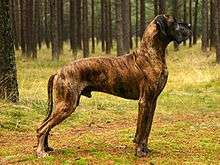
Dogs
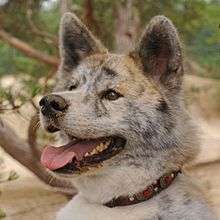
The brindle pattern may also take the place of tan in tricolor coats of some dog breeds (such as Basenjis). This coloration looks very similar to tricolor, and can be distinguished only at close range. Dogs of this color are often described as "trindle". It can also occur in combination with merle in the points, or as a brindle merle, in breeds such as the Cardigan Welsh Corgi, although the latter is not acceptable in the show ring. The "dark" markings are black or the dilutions gray (called blue) or brown (sometimes called red). It is not uncommon for a brindled Cairn Terrier to become progressively more black or silver as it ages.
Cats
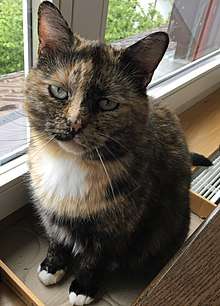
Brindled domestic cats are also known as tortoiseshell cats[1], and in some cases, tabby cat. A domestic brindled cat is almost exclusively female.
Guinea pigs
Brindle is an old variety in guinea pigs. They are difficult to breed to perfection, as the black and red hairs should intermingle evenly all over. Brindle guinea pigs' fur type is Abyssinian (rosetted).
Horses
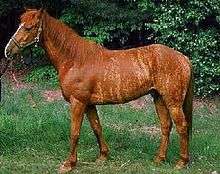
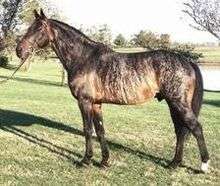
Brindle coloring in horses is extremely rare and in many cases is linked to spontaneous chimerism, resulting in an animal with two sets of DNA, with the brindle pattern being an expression of two different sets of equine coat color genes in one horse. This form is not heritable.[2] In some horses the pattern seems to be inherited, indicating that one or more genes are responsible. One heritable brindle pattern in a family of American Quarter Horses was identified in 2016 and named Brindle1 (BR1).[3] The Brindle1 phenotype has an X-linked, semidominant mode of inheritance. Female horses with this gene have a striped coat pattern, plus hairs from the stripes have a different texture as well as color, less straight and unrulier. Male horses have sparse manes and tails but do not show a striped coat texture pattern. A Brindle1 test is available.[2]
Brindle coloring consists of irregular stripes extending vertically over the horse's body and horizontally around the legs. Brindle horses can also have a dorsal stripe. It usually does not affect the head and legs as much as the body, with the heaviest concentrations of brindling being on the neck, shoulders and hindquarters. The coloring has been documented in the past. At the Zoological Museum of the Academy of Science in Leningrad, a Russian cab horse of brindle coloring from the early 19th century was mounted and put on display due to its rarity.[4]
Description
The brindled pattern found in horses could be described as vertical stripes that are found along the neck, back, hindquarters, and upper legs. The horse's head is usually a solid color and is not affected by the striping. The brindled pattern has no effect on dark points on horses. Some brindle-colored horses are more eye-catching than others.
With this rare coat pattern there is a base coat that covers the entire body of the horse. This base coat color can be any color. Recorded examples have been bay, chestnut, palomino, and dun. Earliest documented cases were said to have red dun or grulla as a base coat. Over top of the base color is either a lighter or darker color, giving the appearance of stripes.
Other animals

Brindle coloring exists in cattle. For crested geckos, the term "brindle" is used to describe a morph with darker stripes of color.[5]
Etymology and literature
The word brindle comes from brindled, originally brinded, from an old Scandinavian word. The opening of Act Four, Scene One of William Shakespeare's Macbeth is often thought to refer to a brindled cat, because it contains the word "brinded": "Thrice the brinded cat hath mew'd." However, in this context, the word "brinded" means branded, as if with fire. The Elizabethan word for "brindled" is "streaked."[6]
- A brindle horse was mentioned in the book Riding Lessons by Sara Gruen.
- "Jock of the Bushveld" was a brindle Staffordshire Bull Terrier mix and the companion of Percy FitzPatrick in their travels around the South African veldt in the 1880s. Fitzpatrick later collected tales of their adventures into a popular book of the same name.
- Jack was a brindle bulldog featured in the Little House on the Prairie books by Laura Ingalls Wilder. He was the companion and household protector of the Ingalls family in their early pioneering travels. He dies of old age at the beginning of By the Shores of Silver Lake.
- In the poem "Pied Beauty" (1918), by Gerard Manley Hopkins, the concept occurs in the opening: "Glory be to God for dappled things —/ For skies of couple-color as a brinded cow; / For rose-moles all in stipple upon trout that swim..." .
See also
- Dog coat
- Equine coat color
- Tabby cat
- Tortoiseshell cat
References
- "Tortoiseshell Cat: Over 30 Fascinating Facts About Tortie Cats". The Happy Cat Site. 2019-05-28. Retrieved 2020-05-05.
- "Brindle Coat Texture,". University of California-Davis Veterinary Genetics Laboratory. Retrieved 2017-02-10.
- Murgiano, Leonardo; Waluk, Dominik (2016). "An Intronic MBTPS2 Variant Results in a Splicing Defect in Horses with Brindle Coat Texture". G3: Genes, Genomes, Genetics. 6 (9): 2963–70. PMC 5015953.
- Lusis, J.A. (1942). "Striping Patterns in Domestic Horses". Genetica. 23: 31–62. doi:10.1007/bf01763802.
In one of the exhibition rooms of the Museum of the Zoological Institute of the Academy of Sciences of the U.S.S.R. in Leningrad there is a stuffed adult domestic horse with stripes. [... It] was purchased – while the horse was still alive – from its owner, a Leningrad cabman, and delivered by the latter to the Museum after the horse's death. Judging by the stuffed object, it was a large horse of the trotter type. [... The striping] closely resembles the striping found in many breeds of cattle and in dogs and known as the "brindling pattern".
in the Brindle Horses site - "Lizards 101: Crested Gecko Morphs and Color Variations".
- Kenneth Muir, The Arden Shakespeare: Macbeth, 1962, p.108
External links
| Wikimedia Commons has media related to Brindle animals. |
